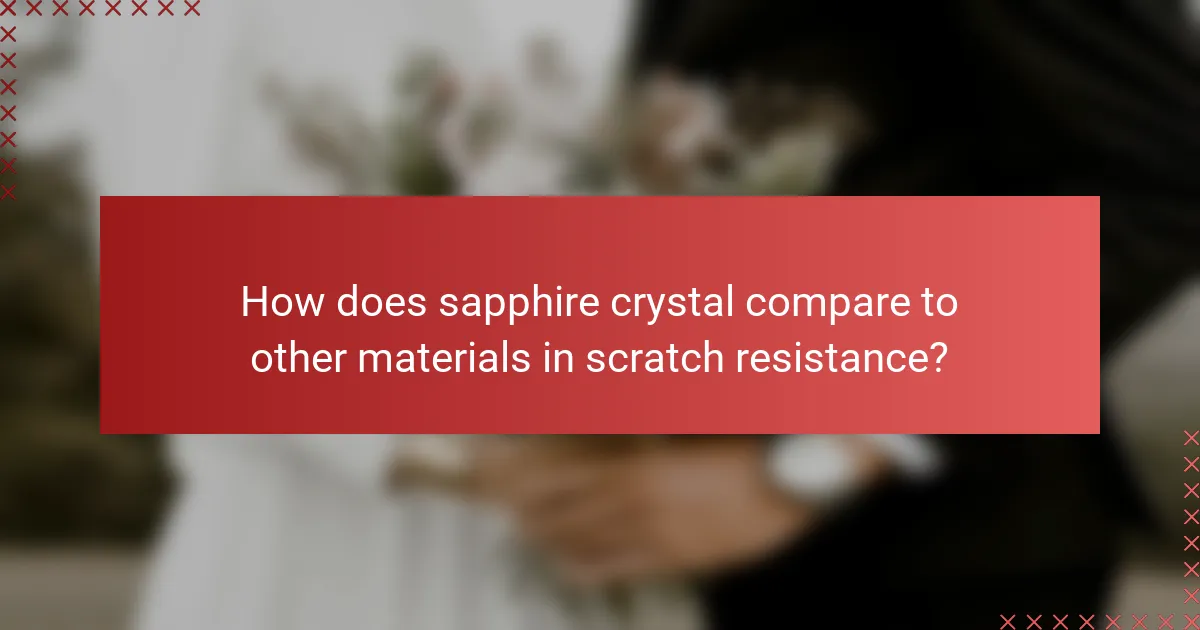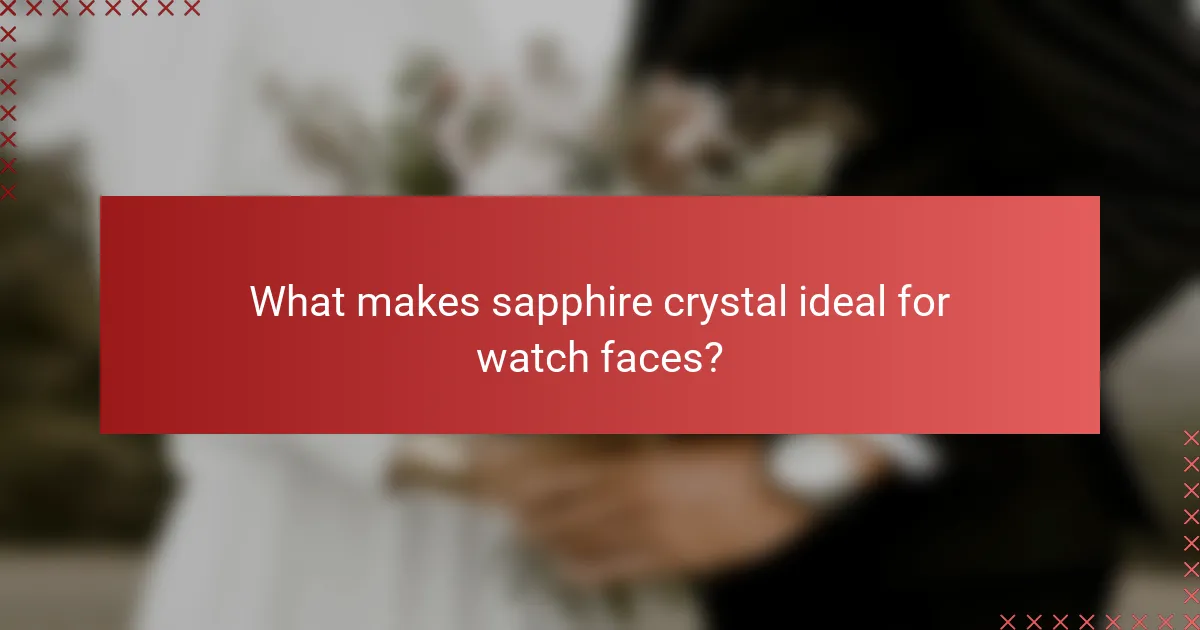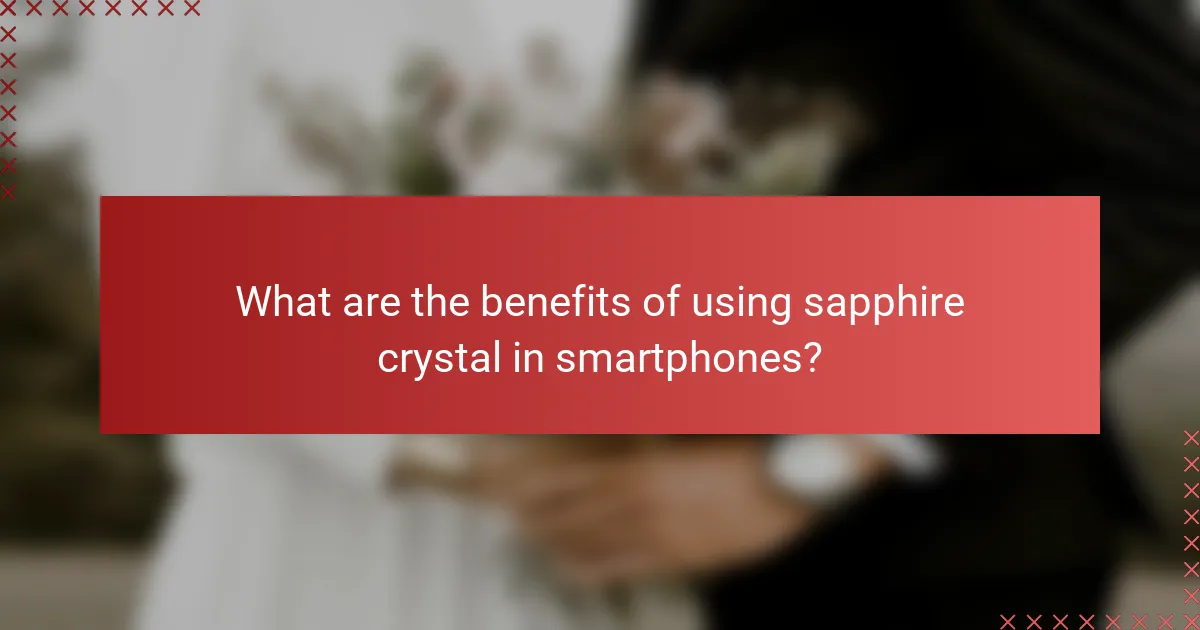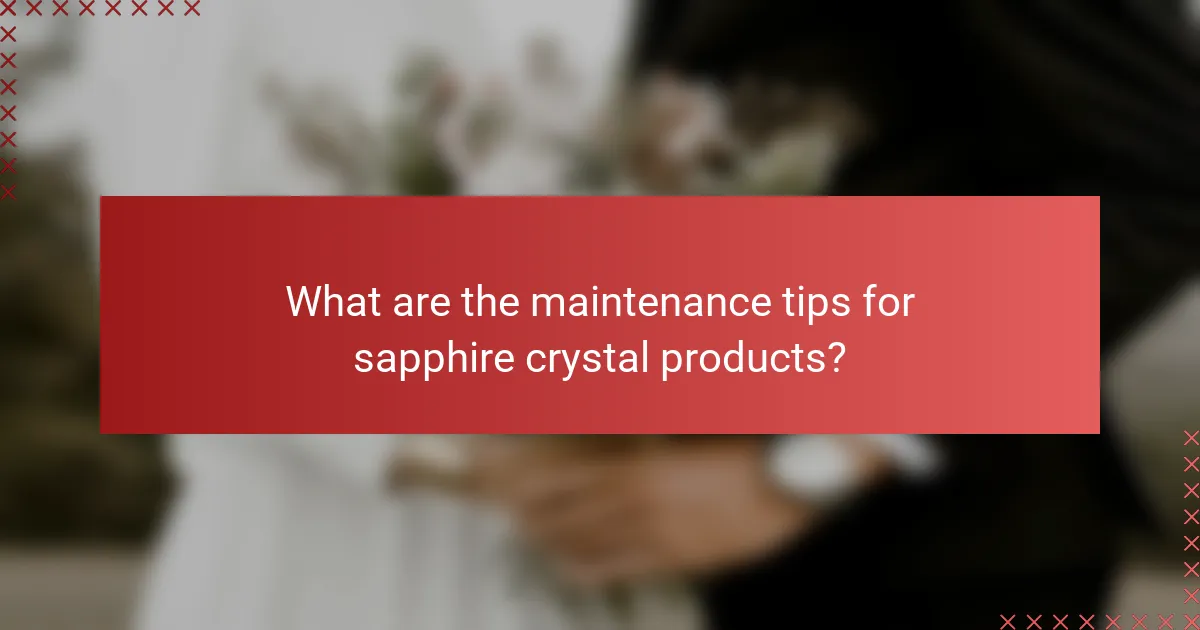Sapphire crystal is renowned for its remarkable scratch resistance, clarity, and longevity, making it a favored material for luxury watches and high-end devices. With a hardness rating of 9 on the Mohs scale, it outperforms alternatives like mineral glass and plastic, ensuring that surfaces remain pristine even with daily use. This durability not only enhances aesthetic appeal but also preserves functionality over time.

How does sapphire crystal compare to other materials in scratch resistance?
Sapphire crystal is significantly more scratch-resistant than many other materials, making it a popular choice for high-end watches and devices. Its hardness, rated at 9 on the Mohs scale, allows it to withstand daily wear and tear better than alternatives like mineral glass and plastic.
Superior scratch resistance compared to mineral glass
Sapphire crystal offers superior scratch resistance compared to mineral glass, which typically ranks around 5-6 on the Mohs scale. While mineral glass can easily be scratched by everyday objects like keys or coins, sapphire crystal remains largely unscathed under similar conditions. This durability makes sapphire a preferred choice for luxury watches and high-end smartphone screens.
Comparison with acrylic and plastic
Acrylic and plastic materials are much softer than sapphire crystal, usually falling between 2-3 on the Mohs scale. This softness means they can be scratched easily, even by light contact with harder surfaces. While acrylic is lighter and cheaper, its susceptibility to scratches makes it less desirable for premium applications.
In practical terms, if you prioritize scratch resistance, sapphire crystal is the clear winner. For example, a watch with a sapphire crystal can maintain its pristine appearance far longer than one with an acrylic or plastic cover, which may require frequent polishing or replacement.

What makes sapphire crystal ideal for watch faces?
Sapphire crystal is ideal for watch faces due to its exceptional scratch resistance, clarity, and longevity. These properties make it a preferred choice for luxury watches, ensuring they maintain their aesthetic appeal and functionality over time.
High clarity and light transmission
Sapphire crystal offers high clarity and excellent light transmission, allowing for a clear view of the watch dial. This transparency is comparable to that of high-quality glass, making it visually appealing while ensuring that the watch remains easy to read in various lighting conditions.
Additionally, sapphire crystal typically has a low refractive index, which means it minimizes distortion and enhances the overall appearance of the watch. This quality is particularly important for watches with intricate designs or features that require precise visibility.
Longevity and durability
The longevity and durability of sapphire crystal are among its most significant advantages. It is highly resistant to scratches and impacts, making it less likely to suffer damage from everyday wear and tear. This resilience means that watches with sapphire crystal can often last for many years without needing replacement.
However, while sapphire crystal is tough, it is not completely shatterproof. Users should still handle their watches with care to avoid potential breakage from severe impacts. Regular maintenance, such as cleaning and proper storage, can further extend the lifespan of the watch face.

What are the benefits of using sapphire crystal in smartphones?
Sapphire crystal offers significant advantages for smartphone displays, primarily due to its exceptional scratch resistance, clarity, and durability. These properties make it an ideal choice for protecting screens from damage and maintaining visual quality over time.
Enhanced screen protection
Sapphire crystal is one of the hardest materials available, ranking just below diamond on the Mohs scale. This hardness translates to superior protection against scratches from everyday objects like keys and coins, ensuring that your smartphone screen remains clear and unblemished.
When considering screen protection, sapphire crystal can withstand impacts better than traditional glass. This resilience means that while it may not be completely shatter-proof, it significantly reduces the likelihood of cracks and chips, providing peace of mind for users.
Resistant to everyday wear and tear
In addition to its scratch resistance, sapphire crystal is highly resistant to everyday wear and tear. This durability allows it to maintain its clarity and aesthetic appeal over time, even with regular use. Users can expect their screens to look new longer compared to those made from standard glass.
For those who frequently use their smartphones in rugged environments or who are prone to dropping their devices, sapphire crystal offers a practical solution. While it may come at a higher cost than regular glass, the long-term benefits of durability and reduced replacement costs can outweigh the initial investment.

What factors affect the clarity of sapphire crystal?
The clarity of sapphire crystal is influenced primarily by the quality of the manufacturing process and the presence of impurities. These factors determine how transparent the crystal appears and its overall aesthetic appeal.
Quality of the manufacturing process
The manufacturing process plays a crucial role in the clarity of sapphire crystal. High-quality production techniques, such as the Verneuil or Czochralski methods, can yield crystals with fewer defects and greater transparency. Poor manufacturing can introduce bubbles or inclusions that diminish clarity.
When selecting sapphire crystal, look for products that specify their manufacturing method. Crystals produced with advanced techniques often command higher prices but offer superior clarity and durability.
Presence of impurities
Impurities can significantly affect the clarity of sapphire crystal. Elements like iron and titanium can create color variations and inclusions, which may reduce transparency. The fewer the impurities, the clearer and more valuable the sapphire crystal tends to be.
To assess clarity, examine the crystal under good lighting. A clear sapphire should have minimal visible inclusions. If purchasing jewelry, ask for certification that details the stone’s clarity and any treatments it may have undergone to enhance its appearance.

How does sapphire crystal’s longevity impact consumer choices?
Sapphire crystal’s longevity significantly influences consumer decisions, as it offers durability and resistance to wear over time. This makes it a preferred choice for watches and high-end devices, where maintaining clarity and scratch resistance is essential.
Longer lifespan than other materials
Sapphire crystal typically outlasts other common materials like mineral glass and acrylic. While mineral glass may last several years with care, sapphire can endure for decades, maintaining its clarity and scratch resistance. This durability is particularly beneficial for items that are frequently exposed to potential damage.
For example, many luxury watches utilize sapphire crystal due to its superior hardness, rated 9 on the Mohs scale, compared to mineral glass at around 5. This means that sapphire is less likely to scratch or degrade, making it a long-term investment.
Cost-effectiveness over time
While sapphire crystal may have a higher upfront cost compared to alternatives, its longevity often results in better value over time. Consumers may spend more initially, but the reduced need for replacements or repairs can lead to savings in the long run.
For instance, a watch with sapphire crystal might cost around $100 to $300 more than one with mineral glass. However, the sapphire watch could last significantly longer without needing replacement, making it a more economical choice over several years.

What are the maintenance tips for sapphire crystal products?
To maintain sapphire crystal products, regular cleaning and careful handling are essential. These practices help preserve their clarity and scratch resistance over time.
Regular cleaning methods
For optimal clarity, clean sapphire crystal surfaces regularly using a soft, lint-free cloth. You can dampen the cloth with a mixture of mild soap and water for more effective cleaning, ensuring no harsh chemicals are used that could damage the surface.
After cleaning, dry the surface with a separate clean cloth to avoid water spots. This simple routine can help maintain the crystal’s brilliance and transparency.
Preventing scratches and damage
While sapphire crystal is highly scratch-resistant, it’s still important to avoid contact with abrasive materials. Store your sapphire crystal items separately from other jewelry or hard objects to minimize the risk of scratches.
When wearing sapphire crystal products, be mindful of activities that could lead to impacts or falls. For instance, remove rings or watches before engaging in sports or manual labor to prevent accidental damage.

What are the emerging trends in sapphire crystal applications?
Emerging trends in sapphire crystal applications highlight its growing use in various industries, particularly in luxury electronics and advanced manufacturing techniques. As technology evolves, the demand for materials that offer superior scratch resistance, clarity, and longevity continues to rise.
Use in luxury electronics
Sapphire crystal is increasingly favored in luxury electronics, particularly for smartphone screens and watch faces. Its high scratch resistance and clarity make it an ideal choice for premium devices, providing durability while maintaining an elegant appearance.
Brands like Apple and Rolex have adopted sapphire crystal to enhance the longevity of their products. This trend reflects consumer preferences for high-quality materials that withstand daily wear and tear, making devices more resilient over time.
Innovations in manufacturing techniques
Recent innovations in manufacturing techniques have improved the production of sapphire crystal, making it more accessible and cost-effective. Techniques such as the Kyropoulos method and the Czochralski process allow for larger, higher-quality sapphire crystals to be produced efficiently.
These advancements not only reduce costs but also enhance the material’s properties, such as clarity and strength. As a result, more industries are exploring sapphire crystal for applications beyond luxury electronics, including optics and aerospace components.
